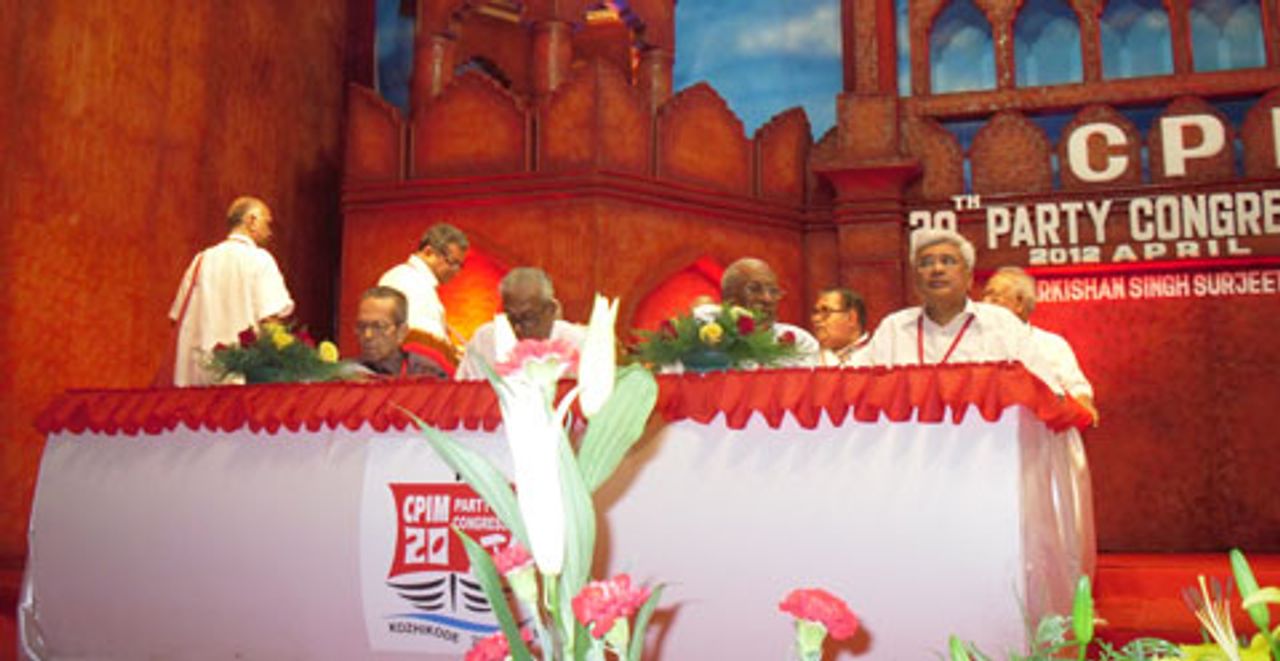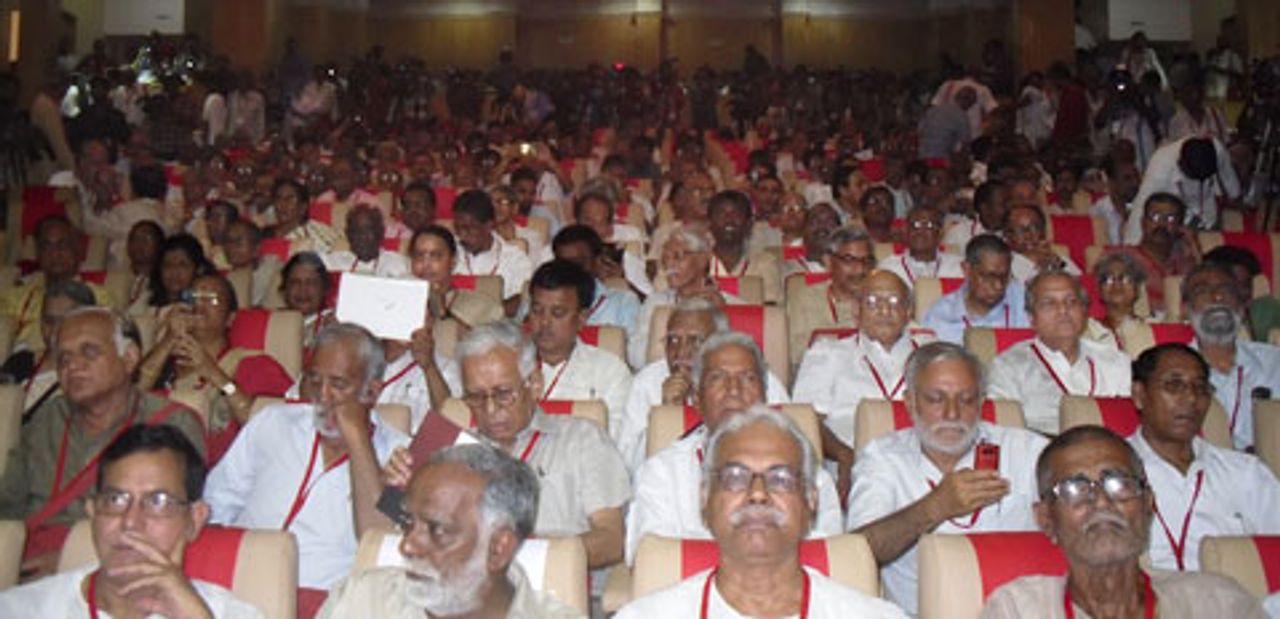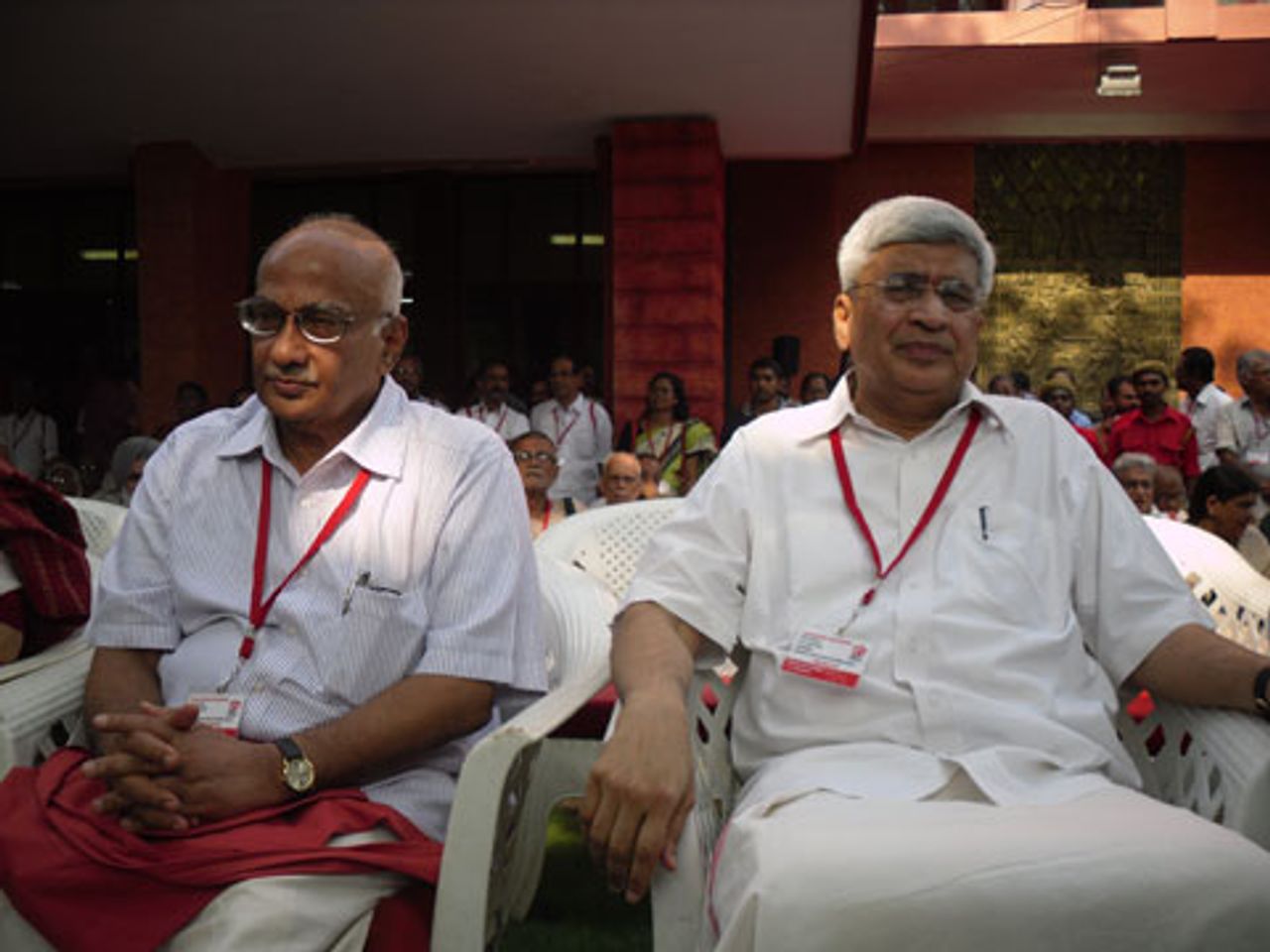India’s main Stalinist parliamentary party, the Communist Party of India (Marxist) or CPM, concluded its 20th national congress last week. According to senior party leaders, the six-day congress adopted the two main resolutions submitted by the party leadership— the “Political Resolution” and a “Resolution on Some Ideological Issues”—without significant amendment.
 The platform at the inaugural session of the CPM congress.The CPM General Secretary Prakash Karat is at right end
The platform at the inaugural session of the CPM congress.The CPM General Secretary Prakash Karat is at right endFor decades, the CPM has functioned as an integral part of India’s bourgeois political establishment, containing and suppressing the struggles of the working class and politically subordinating it to the parties of the Indian bourgeoisie. Although refusing to accept a formal role in India’s national government, it has repeatedly played a decisive part in putting together Union governments and formulating their policies. This includes the current Congress Party-led United Progressive Alliance (UPA) government, which was propped up in parliament by the CPM-led Left Front from May 2004 through June 2008 and whose ostensible Common Minimum Programme was largely written by the CPM. In those states where it has led the government—West Bengal, Kerala, and Tripura—the Stalinist CPM has openly pursued big business’ agenda of market “reform,” dismissing “socialism as a far cry” and proclaiming that there is no alternative to capitalist industrialization.
At its 20th Congress, the CPM formally reaffirmed its “Marxist” character, spurning calls from the capitalist media that it follow the post-1991 lead of many of the European Communist Parties and officially transform itself into a “social-democratic party.” In reality, the CPM reiterated its full-throated defence of the crimes of the Soviet Stalinist bureaucracy, endorsed the brutal capitalist regime that exists in the People’s Republic of China as “socialist,” and, in the name of developing a nationalist “Indian road” to socialism, justified its role as a political prop of the Indian bourgeoisie.
 A section of the the audience at the opening of the CPM's 20th Conhress
A section of the the audience at the opening of the CPM's 20th ConhressWhile conceding that world capitalism is confronting its greatest crisis since the Great Depression, the CPM congress insisted that the balance of class forces on the world scale is decisively in favour of imperialism. For the foreseeable future, all that is possible is to fight within India and internationally for capitalist governments to renounce “neo-liberal” policies in favour of “pro-people” Keynesian policies and to create a “multi-polar world” in opposition to U.S. imperialism. The latter objective is to be achieved by pressing for India to return to its Cold War policy of “non-alignment, strengthening multi-lateral institutions like BRICS and the Shanghai Co-operation Organization (SCO), and supporting Venezuela, Brazil and other “progressive” bourgeois regimes in Latin America.
In their congress resolutions and daily press briefings, the Stalinist leaders made much of the fact that they were eschewing their call for a “program-based” Third Front, comprised of the Left Front and various regional and caste-ist parties, in opposition to the Congress-led UPA and the Hindu supremacist BJP. Instead they emphasized the need to develop a “Left and democratic alternative” based on people’s struggles.
The difference between these two policies is largely semantic. The very same documents that tout the new “Left and democratic alternative” line advocate the CPM and its Left Front enter into electoral alliances with, and prop up governments led by, what it itself describes as the “regional bourgeois parties.” But under conditions where the CPM has suffered a series of major electoral reversals and there are mounting working class and poor peasant struggles, the Stalinists recognize that if they are to restore their influence within the bourgeois political establishment they need to demonstrate to it that they continue to play a vital role in containing popular discontent. Hence, the new-found emphasis on extra-parliamentary protests.
For all their claims to be fighting the “neo-liberal” policies of the Indian bourgeois, the CPM leadership defended the “pro-investor” record of West Bengal’s CPM-led Left Front West Bengal. It attributed the Left’s defeat in last year’s election to various mistakes in implementation, while pointing to “socialist” China, Cuba and Vietnam to argue that an “engagement” with capitalist globalization is unavoidable.
 CPM General-Secretary Prakash Karat (right) and Ramachandran Pillai before the ceremony inaugurating the CPM congress
CPM General-Secretary Prakash Karat (right) and Ramachandran Pillai before the ceremony inaugurating the CPM congressWhen challenged by this writer in a press conference on April 5, to explain the difference between the economic policies of the former CPM-led governments in West Bengal and Kerala and those being pursued by the UPA government, CPM General Secretary Prakash Karat dodged the question. Nevertheless in contending that it would require “at least half an hour” to differentiate the two, he effectively admitted that the Left’s policies and those of the UPA are the same.
The CPM congress was held amidst a serious political and organizational crisis. With the party suffering a significant erosion of its electoral support due to the rightwing record of the CPM-led state governments, a split has developed between the party’s West Bengal unit and the national leadership. These differences were largely papered over at the just concluded party congress.
This was underscored by the re-election of former West Bengal Chief Minister Buddhadeb Bhattacharjee to the CPM Politburo. Citing health problems, Bhattacharjee refused to attend the party congress. He has also absented himself from virtually all national leadership s meetings since the CPM withdrew its support for the UPA government in 2008.
Despite official denials, it is an open secret that the party’s West Bengal unit opposed the national leadership’s decision to withdraw parliamentary support for the Congress-led UPA government in July 2008 and also the CPM’s attempt to form an anti-UPA Third Front in the 2009 national elections. This opposition was rooted in the fear that if the CPM was no long aligned with the Congress nationally, India’s premier bourgeois party would form an electoral alliance with the Trinamul Congress, the CPM’s principal rival in West Bengal.
According to press reports, West Bengal delegates to the CPM congress, including former Left Front Finance Minister Asim Das Gupta, reiterated their criticisms of the national party leadership’s “anti-Congress party line,” while taking exception to the timid criticisms of the former government’s record in the congress “organizational report.” They also insisted that Bhattacharjee is pivotal to reviving the party’s electoral fortunes in West Bengal.
The capitalist media, for its part, lavished praise on the “enlightened reformer” Bhattacharjee, drawing an altogether unjustified stark contrast between him and Karat, with the aim of prodding the CPM still further right.
In terms of the composition of the CPM leadership, it is also of some significance that V.S. Achuthanandan, Kerala’s Chief Minister as recently as last May and the leader of the Official Opposition in the state legislature, was excluded from the Politburo. His arch-rival, Pinnaray Vijayan, the secretary of the Kerala CPM state unit, meanwhile, retained his Politburo seat.
Achuthanandan was elected to the Politburo at the CPM’s 19th Congress in 2008. But he was later suspended for “violating party discipline,” because of his public criticisms of Vijayan for his role in a million-dollar corruption case dating back to his 1996-98 tenure as the state’s power minister.
The factional brawl between Achuthanandan and Vijayan is entirely unprincipled. There is no record of the former opposing the CPM’s role in implementing the Indian bourgeoisies’ post-1991 pro-market “reforms,” nor its pursuit of alliances with all manner of rightwing bourgeois parties. But the 88 year-old former union leader has postured as a defender of CPM “orthodoxy,” as against Vijayan, who has positioned himself as a “moderator” and urged accelerated implementation of pro-investor economic policies.
At an April 8 press conference, senior party leader S. Ramachandran Pillai sought to downplay the “electoral setbacks” the party suffered in West Bengal and Kerala arguing that they were “only one of the indicators” of party strength. He then pointed to the participation of broad layers of workers and toilers in various strikes and protests called by the party’s union federation, particularly last February’s one-day all-India strike, to argue that support for the CPM is expanding.
Contrary to Pillai’s claims, the participation of tens of millions of workers in the Feb. 28 general strike was not an endorsement of the CPM, but an indication of their readiness to fight the Indian bourgeoisie’s program of social spending cuts, deregulation, privatisation, and the “casualisation” of work. The Stalinists, for their part, not only foisted on the strike the reactionary and futile perspective of pushing the Congress-led UPA to adopt “pro-people policies.” They actively sought and hailed the participation in the strike of the union apparatuses affiliated with the Indian bourgeoisie’s two principal parties, the Congress and the BJP.
Among the newly elected members of the CPM Politburo is A.K. Padmanabhan, the president of the CPM-aligned Centre of Indian Trade Unions (CITU). Under Padmanabhan´s leadership, the CITU has been instrumental in isolating and betraying a series of militant struggles waged during the past two years by workers at Hyundai, BYD Electronics and other plants in Tamil Nadu and at Maruti-Suzuki´s Manesar, Haryana car assembly plant. Vehemently opposed to any attempt to broaden these struggles and make them the spearhead of an independent industrial and political offensive of the working class, the CITU has urged striking workers to appeal to the government, courts, and bourgeois opposition parties for support.
In Tamil Nadu, the state from where Padmanabhan hails, this took a particularly grotesque form, with the CITU subordinating workers’ struggles to its pursuit of an electoral alliance with the AIADMK. CITU officials urged workers to abandon militant strikes on the grounds that things would be better when the AIADMK was returned to power, although when it last held office the AIADMK had used mass firings and arrests to break a strike by state government workers. Now returned to power with the Stalinists’ support, the AIADMK government of J. Jayalalitha has continued the viciously anti-worker policies of its predecessor, another erstwhile CPM ally, the DMK.
The author also recommends:
India: Stalinist CPM promotes alliance with regional bourgeois parties
[7 April 2012]
India’s Communist Party (Marxist): Defender of Stalin and capitalist restoration
[6 April 2012]
India: Stalinist CPM holds party congress amid mounting internal crisis
[4 April 2012]
